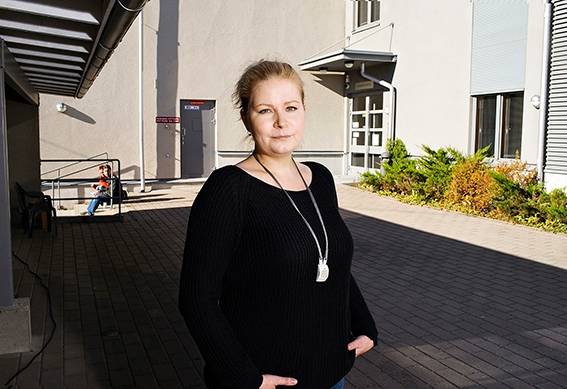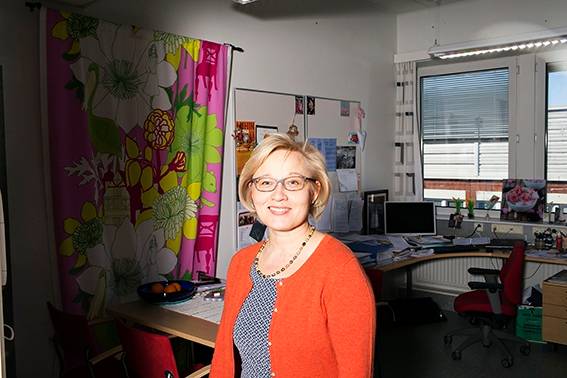Social workers recognize danger signs
Kuvateksti: Every employee has to feel safe at work, and safety must not be a question of money, says Minna Koponen, social service counsellor.
The work of social workers is rewarding, but also demanding and very loading. Threats or even violence are not uncommon. There is zero tolerance to violent behaviour at the social services department of the city of Vantaa.
A police car drives up to the door of Koisoranta social service centre at Vantaa. A moody and bad-tempered client is standing next to the closed doors. The police officers chat a while with the man and the situation resolves.
– The police do not have to visit the centre every day, but they do come around weekly, says Tuovi Häärä, social counsellor and team leader.
– Koisoranta centre has a low threshold for homeless substance abusers who are in rehabilitation. They are welcome to stay overnight temporarily and get counselling for the future. In addition to substance abuse, the clients have mental health issues, and this often leads to unexpected situations. The people who work here are under constant threat of violence.
There are two service units at Koisoranta: The residence unit, on duty for 24 hours, and the unit of start-up services for newcomers. The residence unit is open 24/7 every day of the year. Clients can come in from 12 noon onwards if they are sober. After 4 pm even persons under the influence are admitted. Häärä works in a 13-person team of the residence unit; the members work in three shifts.
In just a few years, the number of threatening and violent incidents has nearly doubled at Koisoranta. Every now and then the workers are attacked physically, but threats are more common.
– Once a client broke down a door and barged in. We escaped into a tiny reception room and waited for the police, while the client made motions of shooting through the glass window.
A clear-cut protocol is followed at the Koisoranta social service centre: No violence or threats of any kind are tolerated. An occupational safety report of all hazardous situations is sent to the HaiPro system. The report goes automatically to the supervisor and the occupational safety personnel. Whenever needed, debriefing can be arranged with the team leaders, team members and occupational health personnel. The client who caused the threatening incident is not allowed to return to the centre before the situation has been analysed.
– Every member of the staff must feel safe at work, and ensuring safety is not a question of money, says team leader Häärä. She wears a pendant with a ‘panic button’, and pressing it alerts the guards immediately.
– We are here to help, and we mostly get thanks for what we do. But it’s important to know that if something does happen, your work-mates and the employer support you.

Leading social counsellor and team leader Tuovi Häärä has an alarm device around her neck when working alone in the client’s home.
We can’t help everybody
The waiting room of the social service station at Tikkurila is small and crowded. A very long corridor stretches out behind the doors. At the end of the corridor is the office of social service counsellor Minna Koponen. She handles residence services for clients who are being rehabilitated for mental health problems.
– My job is to help people who need support for managing their daily routines when settling down in their own home. Our goal is to motivate and encourage these people to get along independently.
The work community of eight persons is not threatened daily. The status of the clients is generally fairly good, and they are undergoing treatment. However, the possibility of violence must be borne in mind. Koponen works alone in the homes of the clients, and has an alarm button hanging around her neck.
– A couple of times I have had to turn back at the door of the apartment. I had an uneasy feeling. Later it turned out that the client had forgotten to take their medication, or there were some other people in the apartment. In this work your safety depends a lot on your own observations and being careful.
At Vantaa, the social workers have together drawn up safety instructions for their visits to the clients’ homes.
– For instance, one rule is that we always go in pairs to the first home visit. Later, a guard can come along, if it seems necessary. We have agreed with our colleagues that we will always call each other if an awkward situation comes up. We also have e-calendars from where our workmates can see our moves.
Koponen knows that the work is sometimes mentally loading. On a couple of occasions she has found a dead client when she went into the home. It’s also a heavy burden knowing that you can’t help everybody.
– And some don’t even want to be helped. On the other hand, it’s encouraging to see that many people do get a grip on their own life and are able to move in the right direction. We have a wonderful work team. You can unload your emotional stress every day, even in the evenings, if you need to.
The well-being of the whole work community must be in order before it can support its members.

Responsibility for the clients weighs heavily on social workers, says Teija Hakulinen, supervisor of social services for adults.
A firm structure provides support
In her work room at the social and health services centre of Koivukylä, Teija Hakulinen, supervisor of social services for adults, goes over the results of a project focussing on the coping and well-being at work of social workers. In the workshops of the project, the employees had discussed problems related to their work.
– The responsibility for the clients weighs heavily on social workers. They have many clients, all with multiple problems, some are traumatized and even violent, Hakulinen begins to list the problems and continues:
– Having to deal with complex problems and to make difficult decisions constantly, having an unclear job description, low appreciation in the organization and the society, and having to handle shocking incidents also stress the workers.
How then does a social worker cope with the daily work load?
– The support from the work community plays a big role. And the well-being of the whole work community must be in order before it can support its members. A positive team spirit and good working conditions as well as the supervisor’s strong support help to guarantee the employees’ well-being.
Hakulinen is responsible for the personnel’s well-being, the strategy, the budget, and administration in three units of Vantaa municipality’s social services department. She says that the department supports its employees for instance with working time arrangements, training, and by offering work counselling every three weeks.
– Threatening or violent incidents are not very common, but they are dealt with individually, and the employee’s recovery – also emotionally – is ensured.
The well-being and work ability of the employees and work communities is followed up continuously at Vantaa. The supervisors serve as sensitive indicators, because they see and hear the problems and are able to react to them.
– Feedback from the clients is also a good indicator. Negative feedback may reflect the ill-being of the work community. When the clients get the help they need and are satisfied, then also the work is rewarding.

Kommentoi